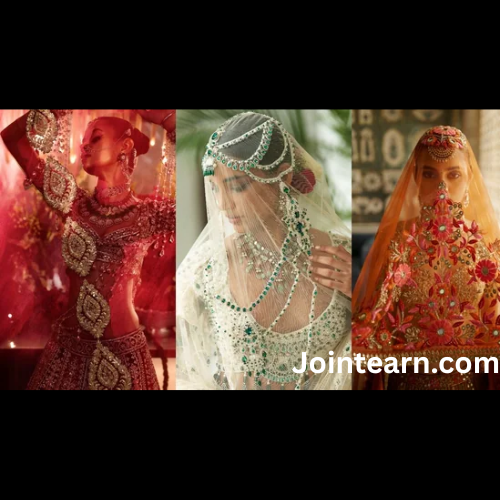
The bridal veil, long considered a traditional finishing touch in Indian weddings, is undergoing a remarkable transformation. Once viewed primarily as a modest covering for the bride, it has now emerged as one of the most significant elements of the bridal ensemble. This wedding season, designers across India are redefining the veil, turning it into a statement piece that commands attention and completes the bridal look with theatrical elegance. From the meticulously embroidered creations of Manish Malhotra to the gem-studded masterpieces of Falguni Shane Peacock, the veil has moved beyond its conventional role, asserting itself as the centerpiece of the bridal outfit.
Traditionally, the veil or dupatta has been symbolic—a subtle accompaniment that completes the attire while reflecting modesty, heritage, and cultural significance. It is often draped elegantly over the bride’s head, signifying grace and tradition. However, modern Indian designers are now reinterpreting the veil in ways that challenge its historical context. No longer merely a complement, the veil is evolving into a canvas for intricate craftsmanship, innovative design, and personal storytelling. This shift reflects a broader trend in bridal couture, where the contemporary bride seeks individuality, opulence, and a sense of grandeur that goes beyond conventional motifs.
Bejewelled and Embroidered Veils Take Center Stage
One of the most striking developments in this evolution is the increasing use of elaborate embellishments. Designers like Falguni Shane Peacock are turning the veil into a sparkling work of art, incorporating emerald stones, pearls, and crystals to create the illusion of vintage jewellery draped across the bride. These bejewelled veils are designed to catch the light and draw attention, ensuring that the bride’s entrance becomes a cinematic moment in itself. Such veils are not merely accessories—they are heirloom-quality pieces meant to be treasured for generations.
Manish Malhotra, another stalwart of Indian bridal couture, has embraced the art of aari and zardozi embroidery on veils. These heritage techniques, which date back centuries, involve painstaking handwork that transforms fabric into ornate storytelling canvases. By employing these traditional crafts in a contemporary context, Malhotra not only elevates the veil’s aesthetic appeal but also revives Indian artisanal heritage for a modern audience. This blend of legacy and innovation highlights a growing trend in bridal fashion: honoring tradition while redefining its presentation for the 21st-century bride.
According to designer Rina Dhaka, today’s bridal veils are maximalist in their approach. “Moving beyond simple borders, modern bridal veils, or dupattas, are being re-envisioned as wearable works of art,” she explains. “They are crafted to make a grand entrance, setting the tone for the entire celebration. The veil no longer plays a secondary role—it is designed to be the visual focal point of the bridal ensemble.” Indeed, the transformation is evident across recent collections, where veils feature dense embroidery, glittering gemstones, and dramatic silhouettes that add depth and grandeur to the outfit.
From Motifs to Narrative: Personalized Veils
Beyond embellishments, contemporary bridal veils are increasingly personalized, incorporating bespoke motifs and symbolic designs that reflect the bride’s story. Designer Shruti Sancheti emphasizes the importance of this trend: “Bridal veils are now featuring bespoke motifs—from delicate butterflies and blooming 3D floral appliqués to celestial patterns—making each piece truly one-of-a-kind.” This customization elevates the veil from a mere garment accessory to a narrative device, capturing moments, emotions, and aspirations. Whether it’s a motif representing familial heritage, love, or personal milestones, the modern veil becomes a medium through which brides can convey their identity and narrative.
This focus on personalization also reflects a cultural shift in bridal fashion. While traditional elements such as Vedic verses, initials, or symbolic designs still find a place in some veils, the contemporary bride is increasingly seeking designs that are more expressive and visually impactful. This new approach allows for creativity in both design and execution, giving brides the freedom to interpret traditional motifs through a modern lens. Designers now collaborate closely with brides to create one-of-a-kind veils that harmonize with the overall aesthetic of the wedding while making a distinct statement.
Maximalism Meets Heritage
A defining characteristic of this season’s bridal veils is maximalism. Gone are the days when a veil was a subtle complement to the lehenga or saree. Today, designers are embracing voluminous silhouettes, bold embellishments, and intricate embroidery to ensure the veil can stand on its own as a show-stopping piece. This maximalist approach often involves layering fabrics, experimenting with textures, and incorporating elements that shimmer or reflect light, creating a visual spectacle as the bride moves.
However, maximalism does not mean forsaking tradition. On the contrary, designers are reinterpreting heritage techniques in innovative ways. The combination of aari and zardozi work, hand-beaded motifs, and gem-studded designs exemplifies how heritage craftsmanship can coexist with contemporary aesthetics. The result is a veil that is at once rooted in tradition and unmistakably modern—grand enough to dominate the bridal silhouette while still complementing the ensemble as a whole.
The Bridal Veil as Art and Heirloom
Perhaps the most remarkable aspect of this reimagining is the shift in perception. No longer viewed simply as a practical or decorative accessory, the veil has become a collectible piece of wearable art. Each veil tells a story, capturing the bride’s journey, love story, and aspirations in fabric, thread, and gemstones. Designer Nachiket Barve observes, “The modern bride is looking for something beyond the Vedic verses and the couples’ initials on the veil, and designers are catering to this demand with utter chicness for brides to make a statement on their D-day.”
The new bridal veil also emphasizes longevity. In previous decades, the veil was often discarded after the wedding, but today’s bejewelled and embroidered pieces are designed to be preserved as heirlooms, passed down through generations, or even repurposed for special occasions. This functional shift underscores the cultural and emotional significance of the veil in contemporary Indian weddings, transforming it from a ceremonial accessory into a tangible memory and symbol of legacy.
A Vision for Modern Brides
In essence, the contemporary Indian bridal veil embodies a delicate balance between tradition and innovation. Designers are pushing the boundaries of what a veil can be—turning it from a modest drape into a statement of artistry, personality, and heritage. The emphasis on intricate detailing, bespoke motifs, and maximalist embellishments allows each veil to become a narrative centerpiece that highlights the bride’s individuality while celebrating cultural aesthetics.
For brides-to-be, this trend represents a thrilling opportunity to experiment with fashion, storytelling, and artistry. A veil is no longer merely a final adornment—it is a centerpiece, a narrative tool, and a work of art. From emerald-studded masterpieces to zardozi-embroidered heirlooms, the possibilities are virtually limitless. Designers are ensuring that each piece not only complements the bridal outfit but also commands attention, turning the bride’s entrance into a truly cinematic experience.
As this wedding season unfolds, the veil has unequivocally claimed its place in the spotlight. It is no longer an accessory that merely completes a look—it is the look. Through thoughtful design, meticulous craftsmanship, and personal storytelling, Indian designers are transforming the bridal veil into a contemporary symbol of grandeur, identity, and artistic expression. For modern brides, this evolution offers the chance to embrace opulence, heritage, and individuality all at once, making the veil not just a part of their wedding day, but a statement to be remembered for a lifetime.


Leave a Reply